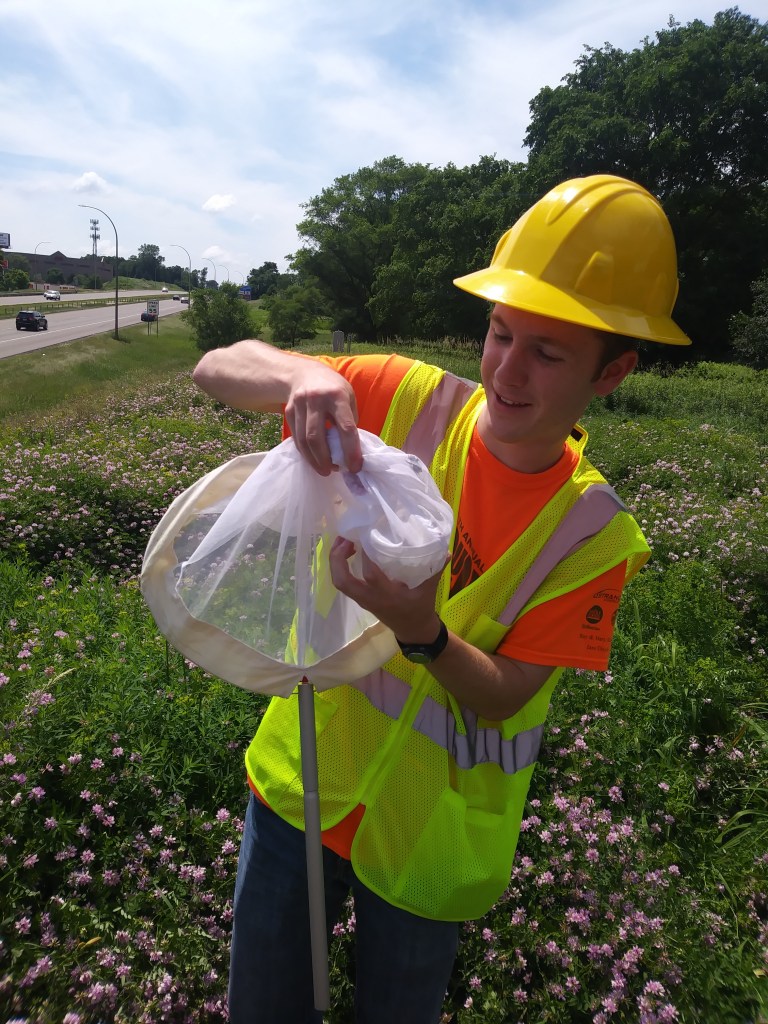Entomologists have developed an innovative method for surveying bumble bees alongside Minnesota roadways, the results of a new research study funded by the Minnesota Department of Transportation.
Research shows that MnDOT roadsides offer rich bumble bee habitats. The study offers information on surveying bee habitats and recommendations for improving habitats.
What Was the Need?
As recently as 20 years ago, the rusty-patched bumble bee was one of the most common bumble bees found from the northeastern and southeastern United States to the upper Midwest. It is no longer found in over 90 percent of its known range, earning federal designation as endangered in 2017.
One of few areas in which Bombus affinis still survives in depleted numbers is the metropolitan area of St. Paul and Minneapolis. Entomologists do not have a strong accounting of bumble bee populations and habitats, in part because of the challenges in counting these and other pollinators. When observers count bees in an area and see no rusty-patched bumble bees, it’s not clear if the bee has been overlooked or if it is absent from the site.
Roadside greenways offer conservation potential for wildlife like bumble bees. Nurturing populations will require recognizing whether species are present in these environments, identifying conditions that favor bumble bee survival in roadside greenways and improving roadsides to offer healthy bumble bee habitat while still serving road user needs.
What Was Our Goal?
The goal of this research was to identify the rusty-patched bumble bee distribution within roadsides of the Twin Cities metro area. Investigators would characterize the bumble bee community in roadsides, estimate detection probabilities and actual site occupancy of B. affinis and other bumble bee species, determine how many surveys were needed to be reasonably certain that bees were absent and identify correlations of landscape features to bumble bee populations.
What Did We Do?
Researchers identified 94 sites along MnDOT-managed roadways in a seven-county Twin Cities metro area. At each location, investigators walked a 250-meter line or transect in that space observing and recording bumble bees present within a meter of the line, and identifying the species or species group to which they belong and the sex of the bumble bees. The researchers also recorded flower species in these transects. Sites were repeatedly surveyed throughout the summer of 2018, with more frequent surveys at sites where uncommon species were identified to improve estimates for these rarer species.

Modeling was used to estimate detection probabilities and true occupancy for each species, as well as the total number of bumble bees per site. “We used survey techniques common in vertebrate biology to help understand the specific habitat needs of the rusty-patched bumble bee, which is unique for surveying endangered insect species,” said Daniel Cariveau, assistant professor, University of Minnesota Department of Entomology. Investigators used statistical analysis to determine the number of surveys necessary for detecting the presence of rusty-patched bumble bees. Researchers also identified landscape features and surrounding land uses to correlate with overall bumble bee abundance, species distribution and the presence of rare species using linear regression models.
What Did We Learn?
This research produced a rigorous method for characterizing bumble bee populations and distribution in roadside environments. Researchers conducted three to 15 surveys at each of the 94 sites, observing 5,304 bumble bees from 12 species or species groups. Results indicate that roadside greenways offer potential to support a species-rich community of foraging bumble bees.
The rusty-patched bumble bee was found at 3 percent of sites, making up 0.5 percent of the surveyed population. “The rusty-patched bumble bee does not appear to rely totally on roadside habitats, but it is part of the puzzle for bee conservation,” said Christopher Smith, wildlife ecologist and Protected Species Program coordinator, MnDOT Office of Environmental Stewardship. The yellow-banded bumble bee, Bombus terricola, which is currently under review by the U.S. Fish and Wildlife Service for classification as endangered, was found at 1 percent of the sites, representing 0.02 percent of bees surveyed.
Most sites offered low or moderate floral abundance and can support more flowering plants and improve bumble bee foraging opportunities. Most of the flowers present are not native to the area, and researchers developed a list of native plants desirable to rusty-patched bumble bees.
Survey methods demonstrate a 30 percent probability of identifying a rusty-patched bumble bee if it is present. At the sites within the study area, researchers estimate that nine surveys must be conducted to reach 95 percent probability of detecting the bee at a single site. The researchers emphasize that these surveys must also be conducted when the colonies are active. Locations with wooded areas within 2 kilometers and greater average floral area had an increased abundance of bumble bees and numbers of species. Developed areas also had increased abundance. Crops, primarily corn and soy, correlated with low bumble bee abundance and species numbers.
What’s Next?
MnDOT can deploy this method for surveying whether a rusty-patched bumble bee is present at its roadsides; this would involve training staff to identify bumble bees. In addition, MnDOT can use data on flowering and land use to improve habitats for rusty-patched bumble bees and other foraging species. When nonnative sweet clover and other species used by the bee are removed, native alternatives can be planted. Improving wooded and flowering conditions near crops and increasing native flowering plants at all sites could improve rusty-patched bumble bee habitat.
This post pertains to Report 2019-25, “Monitoring and Habitat Assessment of Declining Bumble Bees in Roadsides in the Twin Cities Metro Area of Minnesota,” published June 2019.

